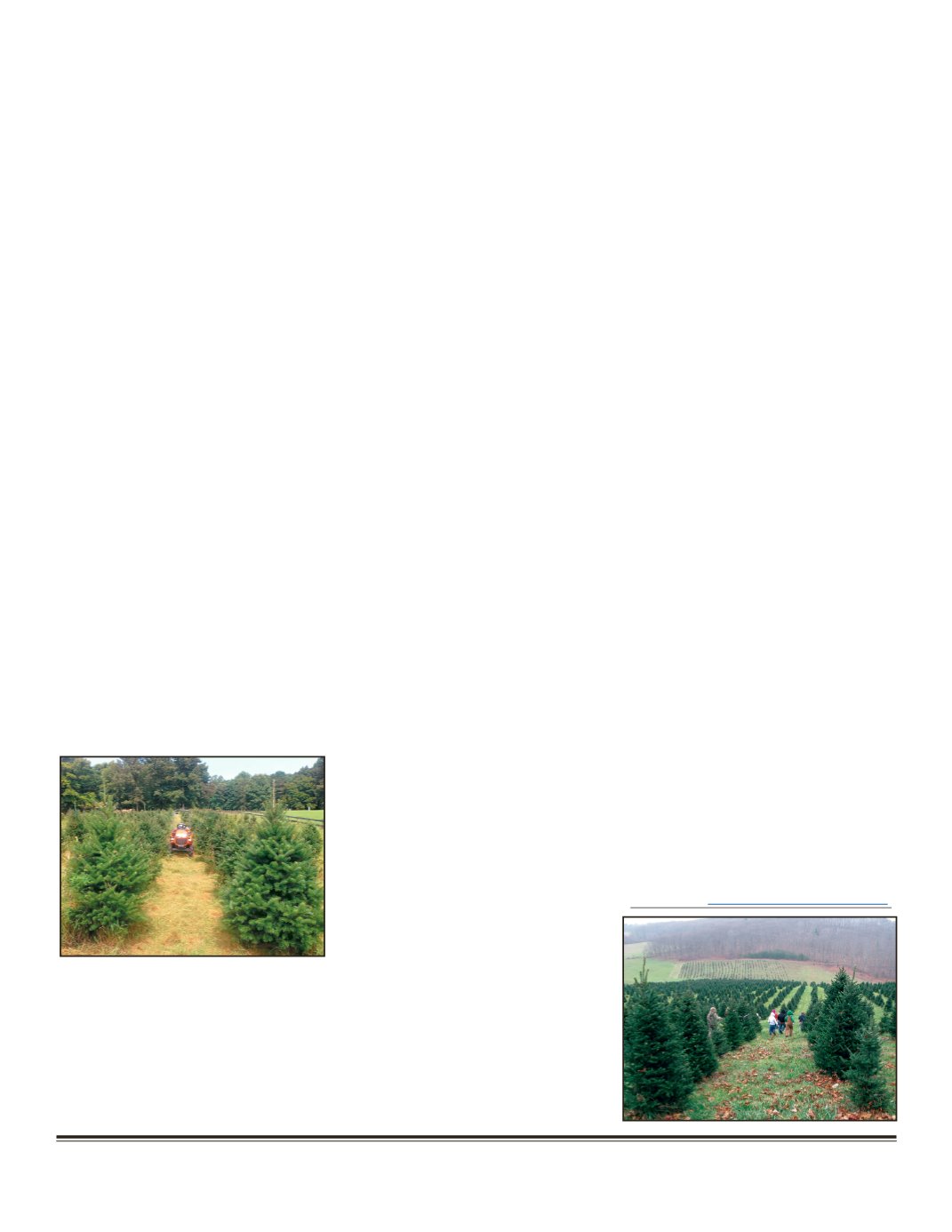

VCTGA News Journal
‒
Spring 2017
| 11
VCTGA News Journal – Spring 2017
Page 11
weed and lambs quarter. The result-
ing stand was mostly white clover
that provided excellent cover for the
next several years. We made a couple
of applications of glyphosate each
year for the next 5 years eliminating
the fescue and maintaining a beauti-
ful crop of clover. Clover is tolerant
to glyphosate, especially at low rates,
but as you would guess other vegeta-
tion made its way into the plantation
like morning glories, crab grass, fox-
tail, annual weeds, poke berry, black-
berry, hardwoods, and of course our
favorite, poison ivy. It took some se-
lective use of herbicides to help con-
trol the morning glories, poke, black-
berry, hardwoods, and poison ivy but
some of the other volunteer vegeta-
tion was beneficial. As the clover
slowed down with the hot dry
weather of summer the foxtail,
crabgrass, and other annuals were
welcome shade for the young trees
and helped keep the soil temperatures
lower. These plants germinate later
and do not usually compete with the
trees during that early initial survival
period. The clover provides a triple
benefit of keeping the soil tempera-
tures lower, holding moisture, and
providing beneficial nitrogen for the
trees. Fescue is not welcome in our
fields anymore, even as a corridor be-
tween the rows.
This plantation is now 5 years old,
mostly 5-6’ Canaan fir and White
pine. With an initial survival of 90%+
we will be ready to start harvesting it
in 2018. A recent photo shows the
field in nearly the same location as
the 2012 photo. Tree size is very uni-
form and impressive for its age. The
white clover is fading from the plan-
tation due to our failure to maintain
the PH and nutrients at a level that is
conducive to clover production. We
applied lime in pelletized form this
spring along with a custom blended
12-30-20 fertilizer; the first applica-
tion in this field since 2011 when the
trees were planted. We have plans to
do some experimental grazing with
sheep in a small area of this field next
summer, a practice used on some Eu-
ropean Christmas tree farms. I may
end up sleeping there to keep an eye
on the trees!
Our normal method in replanting
a field is to get all of the trees off
and then apply bulk lime and nu-
trients as prescribed by a soil test
.
This makes establishing the cover
crop and white clover much easier.
We have been doing this for several
years but you can get behind in your
planting unless you have unlimited
land. Since our customer base is
growing faster than our supply of
trees, we experimented this spring by
replanting a field that had about 10-
15% of the mature trees left. We
could not establish our normal rye
cover on the field due to the 300 or so
mature trees in the field so we de-
cided to let the annual weeds provide
that initial shade for the small trees.
The PH was adequate so we applied
fertilizer at the recommended rate
and planted Canaan fir by the stumps
on about 3 acres in early March. We
had fescue corridors between the
rows of mature trees so we sprayed
the entire field with glyphosate in late
April to eliminate competition from
the newly planted trees. We managed
the cover by bush hogging once in
early summer and then let the weeds
grow until mid- September when we
made another application of glypho-
sate to clean up the field and followed
up by bush hogging one last time.
This would work for most farms that
plant by the stump. It doesn’t look
particularly good but the trees are
better off, soil temps are lower, and
the weeds provide good shade when
the trees really need it. If you wanted
to establish a white clover ground
cover the following fall or winter you
would need to make sure the PH was
between 6.0-6.5, have or apply the
proper nutrients for the clover, and
find an effective way to establish the
clover. We like to use Duran ladino
clover and frost seed in February at a
rate of 5-8 pounds per acre. Getting it
on just prior to a snow is ideal using
pelletized lime as a carrier and either
a hand crank seeder or a tractor
mounted spreader. This sounds pretty
simple but actually it’s quite a bit of
work up front but a time and tree
saver in the long run.
In my opinion, a lot of seedlings
and transplants die because of too
much “love” when they are first es-
tablished.
Planting on bare ground
and maintaining a weed free environ-
ment throughout the growing season
(without having irrigation) will cost
several percentage points in survival
during a normal year and spell disas-
ter in a drought situation. I really pre-
fer using the “good” weeds and clo-
ver to provide the optimum growing
conditions for our trees. Our family is
not unanimous on this management
technique due to its unsightly appear-
ance during most of the summer and
the fall bush hogging that provides an
unpleasant ride on the tractor. Per-
haps if you want the real scoop on
this management tool before you try
it you should contact our tractor op-
erator and farm host, Virginia!
By John Carroll, Claybrooke Farm,
Louisa, VA
claybrookefarm@gmail.com















